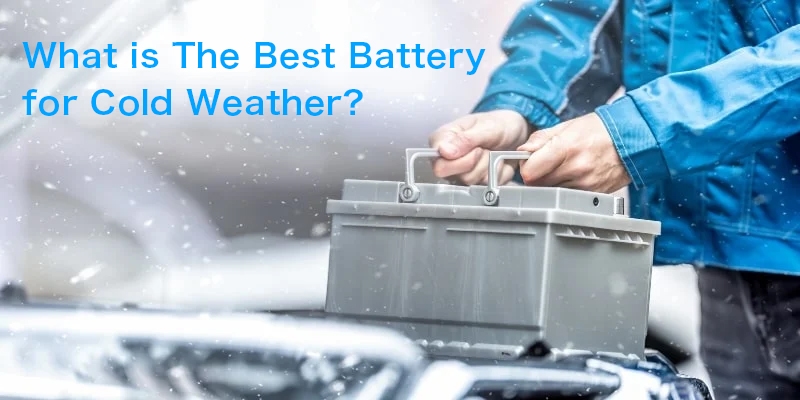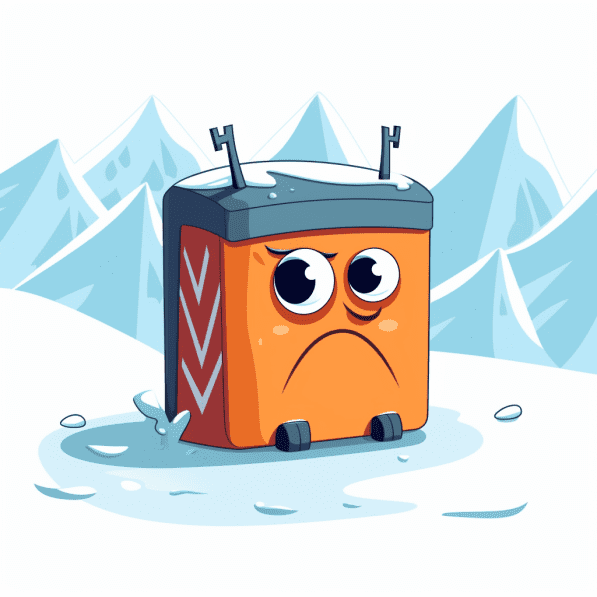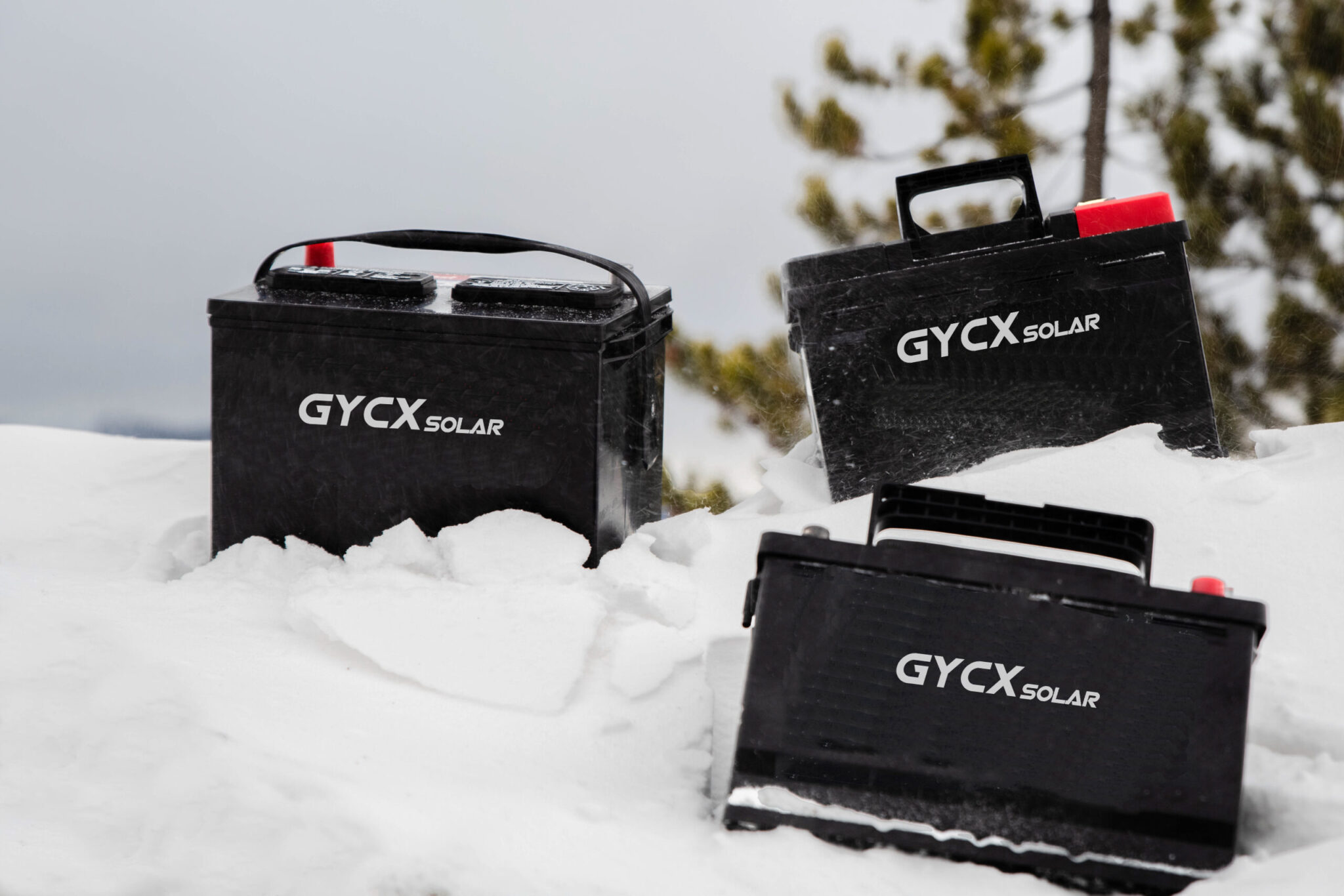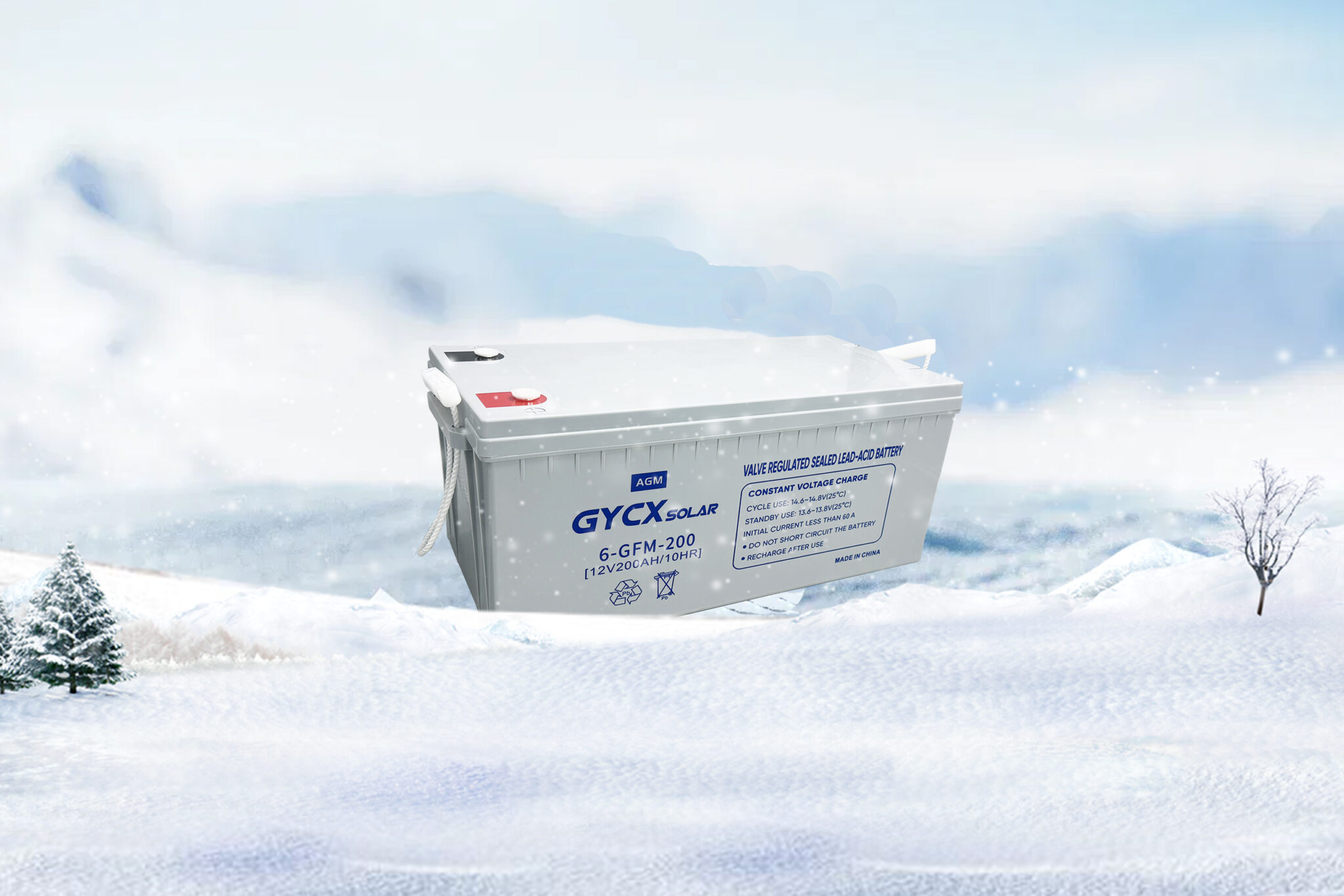Какой аккумулятор лучше всего подойдет для холодной погоды?
Эта статья поможет вам понять работу аккумуляторов в условиях низких температур и научит, как правильно выбрать аккумулятор для холодной погоды..

Почему нужно выбирать аккумуляторы для холодов?
Влияние холода на аккумуляторы:
В холодных условиях, Производительность аккумуляторов обычно снижается, поскольку низкие температуры замедляют скорость химических реакций..
Низкая температура делает раствор электролита внутри аккумулятора более вязким., тем самым препятствуя потоку ионов.
Увеличение вязкости электролита приведет к снижению выходного тока..
Это может привести к снижению производительности электронного устройства., например, трудности с запуском автомобиля.
Кроме того, Холодная погода также может снизить общую емкость аккумулятора., приводя к более быстрому истощению запасенной энергии.
Важность выбора подходящих аккумуляторов для холодной погоды:
Правильный выбор аккумуляторов имеет решающее значение для поддержания стабильной работы устройств в холодном климате..
Аккумуляторы, предназначенные для работы в условиях низких температур, часто содержат электролиты специального состава и улучшенные материалы..
Заседание (Абсорбирующий коврик из стекловолокна) Аккумуляторы славятся своей превосходной работой при низких температурах., а их уникальный дизайн позволяет им хорошо работать в холодную погоду..
По сравнению с традиционными свинцово-кислотными аккумуляторами, литий-ионные аккумуляторы обычно обеспечивают лучшую производительность даже в холодных условиях..
Выбор аккумуляторов, подходящих для холодной погоды, может обеспечить надежность запуска и продлить срок службы аккумулятора..
Какой аккумулятор лучше всего подойдет для холодной погоды?

Литий-ионный аккумулятор
По сравнению с традиционными свинцово-кислотными аккумуляторами, литий-ионные аккумуляторы часто демонстрируют превосходные характеристики в условиях низких температур..
По сравнению с традиционными свинцово-кислотными аккумуляторами, литий-ионные аккумуляторы часто демонстрируют превосходные характеристики в условиях низких температур..
Выбор литий-ионных аккумуляторов, специально разработанных для работы в условиях низких температур, имеет решающее значение для достижения оптимальной производительности в холодном климате..
Заседание (Впитывающий стеклянный коврик) батарея
Заседание (Абсорбирующий коврик из стекловолокна) конструкция батареи поглощает электролит стекловолоконным ковриком.
Эта структура эффективно предотвращает вязкость электролита при низких температурах..
Это гарантирует стабильную и надежную работу аккумулятора даже в условиях мороза., позволяя аккумулятору адаптироваться к воздействию холодной погоды.
Усилители холодного запуска (КЦА) батарея
Аккумуляторы с высокими значениями CCA могут обеспечить хорошую пусковую способность в холодных условиях..
Этот тип аккумулятора может выдавать достаточный ток для запуска двигателя при экстремально низких температурах..
При выборе аккумуляторов, подходящих для использования в холодную погоду, приоритет должен быть отдан тем, у кого более высокие значения CCA, чтобы обеспечить высококачественный пользовательский опыт..
Батарея глубокого цикла
Аккумуляторы глубокого цикла специально разработаны, чтобы выдерживать частые глубокие разряды и быстрые циклы зарядки..
Эта характеристика делает их очень подходящими для использования в холодную погоду., например, в таких приложениях, как корабли и автофургоны.
Эти батареи могут обеспечить стабильную работу в холодном климате и имеют более длительный срок службы..
Выбирайте аккумуляторы глубокого цикла, разработанные специально для холодных погодных условий, чтобы предотвратить такие проблемы, как трудности с запуском или сокращение срока службы аккумулятора при экстремально низких температурах..
Гелевая батарея
В коллоидных батареях используются загустевшие электролиты..
По сравнению с традиционными батареями с жидким электролитом, этот материал менее склонен к замерзанию в условиях низких температур..
Эта специальная конструкция позволяет коллоидным батареям сохранять стабильную работу даже в очень холодных погодных условиях..
Сравнение работы аккумулятора в холодную погоду
Ниже приведена таблица сравнения различных типов батарей., каждый со своими уникальными характеристиками, подходящими для холодной погоды.
Данные включают в себя ключевые показатели, такие как характеристики зарядки/разрядки., холодный пусковой ток (КЦА), и резервная мощность (ЖК):
| Тип батареи | Строительство | Характеристики зарядки/разрядки | Усилители холодного пуска (КЦА) | Резервная мощность (ЖК) |
| Литий-ионный | Литиевая химия | Быстрая зарядка может поддерживать производительность даже в холодную погоду.. | От среднего до высокого | Низкий |
| Заседание (Впитывающий стеклянный коврик) | Электролит поглощается матом из стекловолокна | Быстрая скорость зарядки, низкая скорость саморазряда. | Высокий | Умеренный |
| Усилители холодного пуска (КЦА) | Традиционная свинцово-кислотная кислота | Высокая пусковая мощность в холодную погоду. | Очень высоко | Низкий |
| Глубокий цикл | Усиление платы и конструкция глубокой разрядки | Надежная работа и длительный срок службы в холодную погоду.. | Умеренный | Высокий |
| Гель | Загуститель электролита | Медленная скорость разгрузки, стабильная работа в холодную погоду. | Умеренный | Умеренный |
Факторы, которые следует учитывать при выборе аккумуляторов для холодной погоды

Вы когда-нибудь пытались завести автомобиль на новой энергии холодным зимним утром?, но мне было трудно?
Потому что холодная погода действительно может повлиять на производительность аккумулятора..
Холодная среда может увеличить внутреннее сопротивление батарей., что делает его неспособным эффективно поддерживать или выделять электрическую энергию, как это происходит в теплых условиях..
Это означает, что вам нужно чаще заряжать аккумулятор..
Более того, батарея может выдержать только ограниченное количество зарядов, прежде чем выйти из строя.
Как добиться стабильной работы аккумулятора и продлить срок его службы?
При выборе аккумулятора необходимо учитывать следующие факторы::
Тип батареи:
При выборе аккумуляторов, рассмотрите типы аккумуляторов, специально разработанные для холодного климата..
Например, Заседание (Абсорбирующий коврик из стекловолокна), литий-ионные или коллоидные батареи, известные своими низкотемпературными характеристиками..
Резервная мощность (ЖК):
Учитывая резервную мощность (ЖК) батареи, это относится к продолжительности времени, в течение которого батарея может поддерживать электропитание в случае сбоя электрической системы..
Наличие высокой резервной мощности особенно важно в холодную погоду..
Усилители холодного пуска (КЦА):
Выбирайте аккумуляторы с более высоким током холодного пуска. (КЦА) рейтинги.
Потому что они могут обеспечить более сильный запуск в холодную погоду..
Например, он может гарантировать надежный запуск двигателя автомобиля холодным утром..
Строительство:
Рассмотрим оценку конструктивных элементов аккумулятора, включая используемые материалы и конструктивные характеристики.
Превосходное качество конструкции гарантирует, что аккумулятор имеет достаточную долговечность и может выдерживать обычные изменения температуры в холодном климате..
Совместимость:
Проверьте совместимость аккумулятора, чтобы убедиться, что он совместим с вашим устройством..
Факторы, которые следует учитывать, включают размер., конфигурация терминала, и электрические характеристики.
Гарантия:
Ознакомьтесь с условиями гарантии, предоставленными производителем аккумулятора., который обеспечивает защиту от дефектов аккумулятора и ранних отказов, с которыми вы можете столкнуться в неблагоприятных погодных условиях..
GycxSolar предоставляет высококачественное гарантийное обслуживание для своих аккумуляторные продукты.
В итоге, если вам нужен аккумулятор, способный выдерживать холодные условия.
Поэтому выбор аккумулятора со следующими характеристиками является наиболее идеальным продуктом.:
Способен выдерживать большое количество циклов зарядки и иметь длительный срок службы..
Не разряжается быстро при зимнем хранении..
Оснащен функцией защиты для предотвращения повреждения зарядки в холодную погоду. (если температура слишком низкая, это предотвратит зарядку).
Оборудован обогревателем., он может нагреть аккумулятор до соответствующей температуры зарядки даже при температуре ниже нуля..
Почему лучше всего использовать литий-ионный аккумулятор в холодную погоду?

Аккумуляторы глубокого цикла в основном делятся на четыре категории.:
- Литий (ЛиФеПО4)
- Заседание
- Свинцово-кислотный
- Гель
Среди этих батарей, Литий-ионные аккумуляторы имеют самый длительный срок службы и могут обеспечить зарядку неполного цикла. 3000 к 5000 раз.
По частоте использования, срок службы может превышать 10 годы.
В отличие, свинцово-кислотные аккумуляторы могут поддерживать в среднем только около 400 циклы зарядки, со значительной разницей.
Поэтому, с точки зрения долговечности, литий-ионные аккумуляторы являются одними из лучших.
С точки зрения производительности при экстремальных температурах, литий-ионные аккумуляторы также превосходят других конкурентов.
Высокая энергоэффективность литий-ионных аккумуляторов снижает потери энергии и сводит к минимуму необходимость частой зарядки в холодных условиях..
Кроме того, Литий-ионные аккумуляторы также являются идеальным выбором в холодную погоду., по причинам, включая:
1. Среди всех типов аккумуляторов, его скорость саморазряда самая низкая, только о 2% в месяц.
В отличие, Скорость саморазряда свинцово-кислотных аккумуляторов достигает 30% в месяц.
2.Имеет защиту от утечки, бескислотный, и некоррозионные свойства.
Свинцово-кислотные аккумуляторы имеют самую низкую стоимость., но их также легче всего испачкать.
Никто не хочет вытряхивать и чистить пятна на аккумуляторе на морозе..
Литиевые аккумуляторы состоят из различных химических компонентов и не содержат кислотных веществ., делая их чище и удобнее.
3.Литиевые батареи — самый надежный выбор в холодную погоду..
Благодаря своим некислотным химическим свойствам, литиевые батареи сохраняют более высокую стабильность в холодном климате.
Так что вам не придется беспокоиться о том, что аккумулятор выйдет из строя в критические моменты., например, при температуре ниже нуля или вдали от розеток.
Советы по использованию аккумуляторов в холодную погоду

Регулярно заряжайте аккумулятор:
Регулярная зарядка помогает поддерживать оптимальную производительность аккумулятора., предотвращение замерзания или падения в холодную погоду.
Изолированная батарея:
Используйте изоляционные материалы или крышки аккумулятора, чтобы изолировать аккумулятор зимой..
Уменьшите риск затвердевания электролита и продлите срок службы аккумулятора..
Уменьшите ненужное энергопотребление:
Отключите ненужное электрооборудование, чтобы снизить потребление энергии аккумулятора в холодную погоду..
Поддерживайте заряд батареи и продлевайте срок ее службы.
Очистите клеммы аккумулятора:
Содержите клеммы аккумулятора в чистоте, свободный от коррозии, и обеспечить хорошие электрические соединения.
Улучшение проводимости аккумуляторов во время использования особенно важно в холодную погоду..
Вариант с подогреваемой батареей:
Обычные аккумуляторы нельзя заряжать при температуре ниже точки замерзания., но встроенный нагревательный элемент может нагревать аккумулятор до тех пор, пока он не достигнет безопасной температуры зарядки..
Чтобы получить больше преимуществ, Вы можете рассмотреть возможность использования специальной батареи для холодной погоды, оснащенной функцией обогрева..
Выбор литиевой батареи с этой функцией обеспечивает отличную стабильность работы вашего устройства в холодную погоду..
Часто задаваемые вопросы и ответы

Какие аккумуляторы лучше всего подходят для холодной погоды?
Заседание (Абсорбирующий коврик из стекловолокна), литий-ионный, и коллоидные батареи являются идеальным выбором для холодной погоды благодаря их способности сохранять работоспособность в условиях низких температур..
Вам нужен аккумулятор, разработанный специально для холодных условий??
Необходимо выбирать аккумуляторы, специально разработанные для низких температур, чтобы обеспечить стабильные пусковые характеристики и избежать снижения производительности в холодных условиях..
Могут ли литиевые батареи нормально работать в холодных условиях??
Литиевые батареи обычно работают лучше, чем традиционные щелочные батареи в холодном климате., с более высокой удельной мощностью и способностью сохранять хорошие характеристики в условиях низких температур..
Литиевые батареи для холодной погоды лучше, чем щелочные?
Литиевые батареи обычно работают лучше, чем щелочные, в холодную погоду..
Они демонстрируют отличную производительность и надежность., обеспечение непрерывной мощности даже при экстремально низких температурах.
Какой тип аккумулятора лучше всего выдерживает перепады температур?
Литий-ионные аккумуляторы.
Его высоко ценят за отличную термостойкость и стабильность в различных температурных условиях..
Это позволяет им адаптироваться к постоянно меняющимся климатическим условиям..
